Trade up! | Part 6: The cut-out
“Copycats are cool cats”, Kyle MacDonald writes in his blog. In July 2005, the Canadian offered to swap his red paperclip, and within a year he had swapped himself a house. Nope, we’re definitely not the first to start this game. And we’re not looking to acquire a house, either. We’re just really looking forward to the swaptastic journey through TU/e that lies ahead, and who we’ll meet along the way. Keep track of our barter here and don’t hesitate to e-mail us if you see an item you love, and you’re willing to exchange it for something ever better.
‘Hope for the best, expect the worst. Some drink champagne, some die of thirst.’ A quick lesson in expectation management by Joep Huiskamp, just before we visit him, as we happen to be extremely curious ever since his General Affairs Department colleague Rozemarijn Schalkx, whom he shares an office with, let us know Huiskamp is interested in a trade with Cursor. Our curiosity is boosted by her remark that University Secretary Nicole Ummelen has already set her mind on the object he’ll be trading with us. And that’s before we’ve even paid Huiskamp a visit!
So now we wait for a sign from Huiskamp: Executive Board staff, and particularly concerned with academic heritage. And, yes, quite the collector. There was a lot to pack when he had to exchange his beloved 'porter’s lodge' at the corner of the Hoofdgebouw last week after some thirteen, fourteen years, for a smaller, shared room on the third floor of MetaForum. “But we still have a view on the Hoofdgebouw.” Grinning: “The grey tones of the building match the dreariness of this room.”
It was mostly books he had to pack and gave away. He gave several items and visual material to Erik Geelen, coordinator academic heritage at the Information Expertise Center. A bunch of old film tins was transferred to MetaForum, however: they now serve as a stand for his computer screen.
Former Rector Kees Posthumus also survived the move, in 2D. Huiskamp once found the giant portrait in the scullery of the recently deceased painter Peer van den Molengraft. “It was hanging over his freezer, covered by a Fabeltjeskrant poster.”
The Eindhoven painter had made the painting by commission of Sam van Embden, designer of the Auditorium. He wanted to adorn the Senate Hall with large paintings of TU/e Rectors, but photos were used, and the portrait of ‘test model’ Posthumus never left the painter’s home. Until TU/e purchased it after all seven years ago. Pending a more prominent location on campus it was put up in Huiskamp’s lodge. “It’s immense, but it’s a beautiful and powerful portrait.”
The TU/e ‘campus historian’ hopes the painting will grace the walls of the renovated Hoofdgebouw one day. “Wouldn’t it be wonderful if those perfectly modern and multifunctional buildings also showed where it all began? If they featured important people like Posthumus, but items from the past as well?”
Connecting the themes of days past with today, “showing the timeline as an experience” - that’s Huiskamp’s ideal. “The past in itself isn’t very captivating, unless you connect it to the here and now. And in light of the many foreigners who come here for work and studies, it’s good to be able to show where we came from, with what intentions and ideals our university was founded once, and how these are still ingrained in our system.”
His desktop background shows a picture of a switchboard in the lab of Professor Elena Lomonova of Electrical Engineering. There’s a good chance it won’t survive, as Dura Vermeer is about to sink its teeth into Potentiaal to transform it into a residential tower. Perhaps the architect (and TU/e alumnus) involved, Bert Dirrix, takes Huiskamp’s hint. The latter sent the architect an e-mail with a picture of the switchboard and the suggestion to save it and feature it in a possible student bar in the building, for example. “It would be a gorgeous piece that shows current generations what once was.”
Outside university, Huiskamp is concerned with saving historic heritage. He’s part of the board of a foundation that’s lobbying for a reconstruction of Le Corbusier’s Philips Pavilion that was built for the World Expo in 1958. Years of research have gone into the project already. “Can it be rebuilt at all? And if so, what should we do with it?” And: where to build it? And then there’s the price tag of over eight million euros.
Whoever does not want to wait for the real-life reconstruction can start on a miniature. Huiskamp is donating us a model of the Philips Pavilion, which was part of the TU/e Christmas gift basket five years ago. A collector’s item already, if we are to believe Huiskamp. We learned it was a popular item during previous trading trip, when GEWIS board member Bor de Kock pulled it from a crammed cabinet and quickly appropriated it.
Oh, it still needs to be assembled, although Huiskamp urges the recipient to leave it as it is: “I wouldn’t try it, it’s too meticulous. It’s perfectly fine in the box.” The heritage hero doesn’t mind the recipient taking off the wrapper, by the way: “Anyone can do with it as they please. Let’s not glorify it too much”. Huiskamp also donates a summary of a feasibility study into the reconstruction of the Philips pavilion, “just because it’s a fascinating story”.
The newly-acquired craft project of Electrical Engineering is exhibited on top of the cabinet of colleague Schalkx. There it is, looking all historical and technical next to a sparkling fuchsia hat.
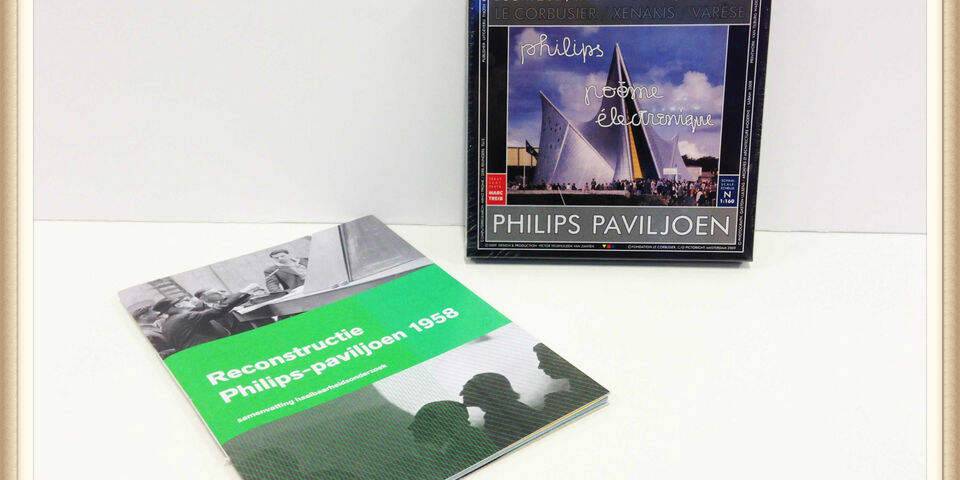

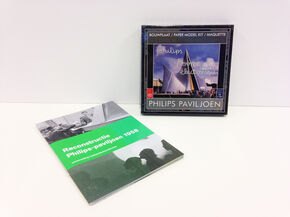
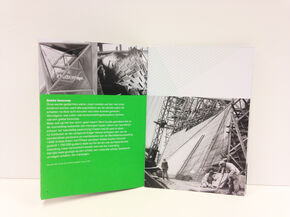
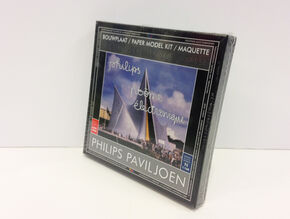
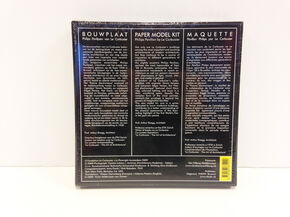
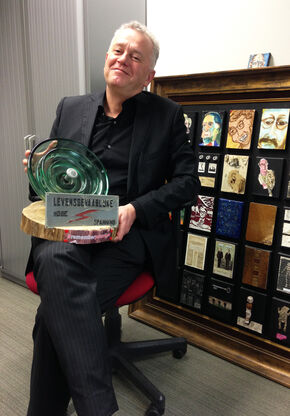
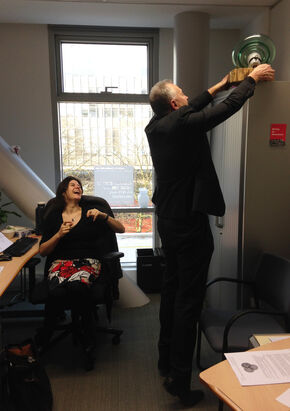
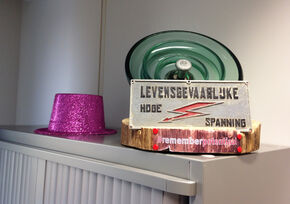
Discussion